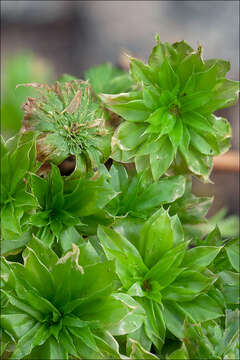Rhodobryum-ontariense_4

Description:
Rhodobryum ontariense (Kindb.) Kindb., syn.: Rhodobryum spathulatum (Hornsch.) PoesEN: Rose-moss, DE: Rosenmoss, Ontario-Rosenmoos, Slo.: ?Dat.: Nov. 9. 2018Lat.: 46,358914 Long.: 13,699772Code: Bot_1162/2018_DSC3920Habitat: Light mixed wood, Fagus sylvatica, Picea abies, Fraxinus ornus, Ostrya carpinifolia dominant trees; slightly inclined mountain slope, south aspect; relatively dry and warm place; in half shade; calcareous, colluvial, skeletal ground; partly protected from direct rain by tree canopies; average precipitations ~ 3.000 mm/year, average temperature 7-9 deg C, elevation 600 m (2.000 feet), alpine phytogeographical region. Substratum: thin soil layer on calcareous rock.Place: Lower Trenta valley, between villages Soa and Trenta, next to the trail from Strgulc abandoned farm house to Trenta 2b cottage, East Julian Alps, Posoje, Slovenia EC. Comment: Rhodobryum ontariense is a very beautiful and quite distinct moss. Its relatively large, terminal 'rosettes' of leaves (more than 1 cm in diameter), which develop on top of short steams resemble green roses (see its names). To recognize genus is not difficult, however, on species level there exist two of them, which are very similar - Rhodobryum ontariense first described in America at the end of 19th century and Rhodobryum roseum first described in Europe approximately at the same time. Later both names have long been considered as synonyms. Rhodobryum roseum has been commonly thought to be a species widely distributed in the temperate and boreal zones of the Northern Hemisphere including Europe, North America, and some areas in Asia. Only in 1972 a thorough revision of the genus (Ref.: 7) separated them again into two species. Rhodobryum ontariense can be distinguished from Rhodobryum roseum by its smaller size (Rhodobryum ontariense is 2 - 3 cm tall and Rhodobryum roseum 5-6(10) cm (Ref.: 3)). The measured height of this find was from 1.5 to 2 cm. The number of leaves in the rosette is another distinguishing trait. Rhodobryum ontariense has 18 -52 leaves in each and Rhodobryum roseum from 16 to 21 leaves. In this find rosettes with more than 40 leaves were frequent. Also preferred substratum and habitat differ. Rhodobryum ontariense prefers dryer places and grows predominantly on calcareous rocks, while Rhodobryum roseum prefers moister places and is found mostly on soil (Ref.: 3). All this speaks in favor of Rhodobryum ontariense. Sporocarps are not distinctive and they anyhow develop very rarely. I haven't seen them yet.Ref.:(1) V. Wirth, R. Dll, Farbatlas Flechten und Moose, Ulmer (2000), p 255.(2) I. Atherton, S. Bosanquet, M. Lawley, eds., Mosses and Liverworts of Britain and Ireland, British Bryological Society, (2010), p 600(3) M. Nebel, G.P hilippi, eds., Die Moose Baden-Wrttembergs, Verlag Eugen Ulmer, Vol: 2. (2001), p 103.(4) W. Rothmaler, Exkursionsflora von Deutschland, Niedere Pflanzen, Band 1, 3.Aufl., Spectrum Akademischer Verlag (2005), p 743.(5) ohiomosslichen.org/moss-rhodobryum-ontariense/ (accessed Nov. 13. 2018)(6) Z. Iwatsuki and T. Koponen, On the taxonomy and distribution of Rhodobryum roseum and its related species (Bryophyta), Acta Botanica Fennica 96 (1972); accessible at: scholar.google.si/scholar?q=Iwatsuki+1972+Rhodobryum&... (accessed Nov. 13. 2018)
Included On The Following Pages:
- Life (creatures)
- Cellular (cellular organisms)
- Eukaryota (eukaryotes)
- Archaeplastida (plants)
- Chloroplastida (green plants)
- Streptophyta
- Embryophytes
- Bryophyta (mosses)
- Bryopsida (True Mosses)
- Bryales
- Bryaceae
- Rhodobryum (rhodobryum moss)
- Rhodobryum ontariense (Ontario rhodobryum moss)
This image is not featured in any collections.
Source Information
- license
- cc-by-nc-sa
- copyright
- Amadej Trnkoczy
- photographer
- Amadej Trnkoczy
- original
- original media file
- visit source
- partner site
- Flickr Group
- ID


